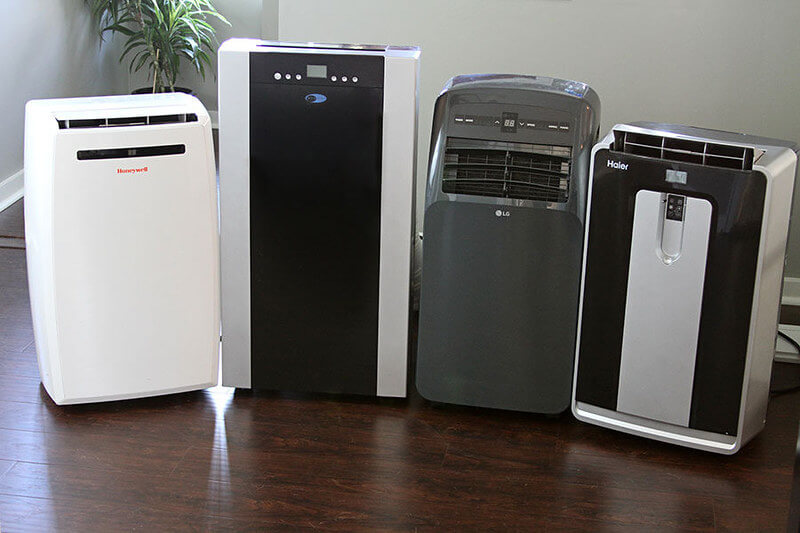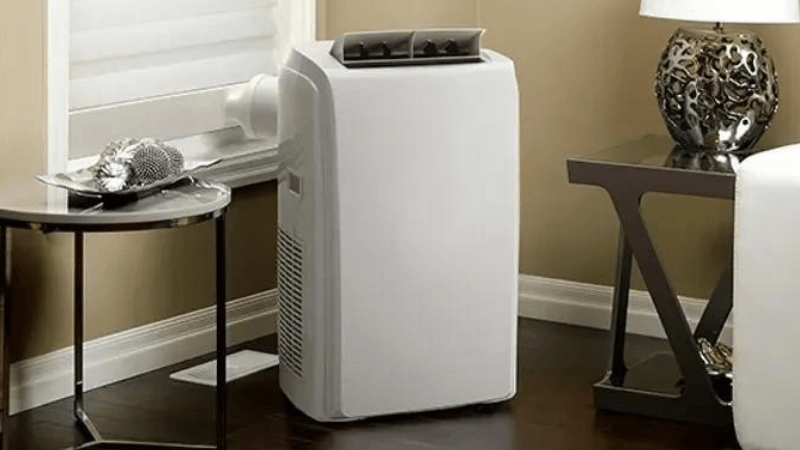Portable home cooling units, like portable air conditioners and evaporative coolers, are a great alternative to
centralized air conditioning. They are the best choice, especially for those living in rental properties or small apartments. They both have a compact design and offer mobility.
Though these cooling units cool down a room, they differ in several characteristics.
In this post, you will learn how each of these cooling units works, their pros/cons, how to select the right type for your home, plus our top picks.
Evaporative Coolers
An evaporative cooler also called a swamp cooler, is a type of air conditioning that offers an eco and budget-friendly way of cooling down spaces. Evaporative air conditioners work by using the evaporation principle to lower the temperatures.

Liquids evaporating from a surface have a cooling effect. This is because evaporation requires heat energy to convert the liquid into gas. For evaporation to occur, heat energy from a surface needs to change a liquid into a gaseous state. As evaporation happens, it pulls the heat from a surface with it. This leaves a cooling effect on the surface and thus the name evaporative cooling.
The same evaporative cooling process happens when you sweat or place a moist piece of cloth on your forehead on a hot day. As sweat evaporates from your skin or the cloth, it helps in lowering your head’s temperature.
How do Evaporative Coolers Work?
The scientific principle of evaporation applies to evaporative coolers. However, evaporative coolers do it better and more efficiently to lower the temperature of a room.
In general, an evaporative cooler unit will have a fan, water-absorbing or evaporative pads, and a water reservoir. Different additional features can be available depending on the model in question.
The fan draws hot, dry air into the cooler and forces the air across the evaporative pads. The pads are soaked with water, heat is absorbed as hot air passes through them, and cool air is pumped back into the room. This process is what is called evaporative cooling.
Portable Air Conditioners
Air conditioning sucks hot air from home, cools it, and brings in drier, cooler air. Central air conditioners are the most popular type of air conditioning in most homes. A portable air conditioner is a great alternative without dealing with a permanent installation or in rented apartments that do not permit window air conditioning units.

Portable air conditioners apply the same concept as central and window air conditioners but are compact and portable. They are also easy to use and require less installation than other air conditioners.
How Portable Air Conditioners Work
Portable air conditioners use three components to cool down the temperature in a room. The refrigerant cools the air, a compressor compresses the refrigerant, and a fan sucks and exhausts air.
The fan first sucks hot, humid air from your home. Inside the unit, the hot air is passed through refrigerant or evaporator coils, where heat is transferred to the refrigerant. When the refrigerant absorbs heat, moisture condenses on the coils. It is then gathered and can be vented outside or manually drained by removing the bucket.
The cool and dry air is then vented back to the room. The refrigerant, after absorbing heat, changes state to gaseous form and goes back to the compressor, where heat is released and vented out via an exhaust vent installed through a window or an opening in the room.
The two types of portable air conditioners are single-hose and double/dual-hose portable AC. Single-hose portable air conditioners have only a single hose that serves as an exhaust vent for hot air.
Dual-hose portable air conditioners have two hoses, one for sucking in fresh air from outdoors and a second for venting out hot air. However, double-hose portable air conditioners are less common, expensive, and difficult to install. The Whynter ARC-14S 14,000 BTU Dual Hose Portable Air Conditioner is a good option you can check out.
Evaporative Coolers vs. Portable Air Conditioners
Choosing an evaporative cooler or portable air conditioner will depend on several factors. Consumers should carefully weigh these factors against their preferences and budget to find the perfect home cooling unit. Below are some factors you can look out for before settling on any portable cooling units.
Climate Considerations
Hot weather is different depending on the location. For example, Arizona is hot and dry, while Florida is hot and humid. People living in both these areas require air cooling in their homes. However, the portable air cooling method used will determine how effective it will be in lowering the temperatures.
Evaporative coolers work best in hot and dry climatic areas. Apart from cooling the air in your home, evaporative coolers will boost the humidity in your home, eliminating the need for a humidifier to keep your skin and nasal passages moist. In dry but humid areas, an evaporative air conditioner might not be as effective and might increase the humidity, which comes with its fair share of problems.
In dry and humid areas like Florida, the only way you can bet beat the heat is to lower the humidity. A portable air conditioner is the best cooling unit for areas like these. A portable air conditioner removes excess moisture and then blows out dry air. So, apart from cooling, it also doubles up as a dehumidifier.
Costs & Energy Efficiency
Portable air conditioners are generally more expensive to purchase compared to evaporative coolers. Apart from the initial cost, they also require more energy, thus a higher electric bill and maintenance costs.
Evaporative air coolers are a bargain if you live in a hot and dry climate. They are more economical to purchase, use less energy, and have low maintenance costs.
Installation, Maintenance, & Portability
When installing a portable air conditioner, the unit must be near an opening like a window or door to vent hot air outside. Unless the exhaust vent is going through a wall, the installation process does not require a professional and can be carried out by a homeowner. Maintenance of portable air conditioners includes:
- Changing the water reservoir in some models.
- Cleaning.
- Changing the filter.
- Replacing the chemicals involved.
- They also have more working parts that could fail, which may be costlier to replace.
For evaporative coolers, there are no installation costs involved. A unit is functional straight from the manufacturer. However, they require daily, monthly, and yearly maintenance to keep functioning optimally. Maintenance includes filling the reservoir with water and changing the evaporative pads when needed. The homeowner can do this by following a model’s instructions.
For portability, you have to give it to an evaporative cooler. It is a free-standing unit that can be moved easily around your home. Evaporative air coolers can also work outdoors to cool patios, balconies, or backyards.
A portable air conditioner is not entirely portable. However, removing and placing it in another room is easy if required.
Apart from the above reasons, there are other things to consider, such as environmental impact, noise levels, CO2, and numerous features that allow these portable units to do more than cool your home down.
Our Top Picks
- LG LP1419IVSM Portable Air Conditioner – Our Best Portable Air Conditioner
- BLACK+DECKER BPACT08WT Portable Air Conditioner – Budget Portable Air Conditioner Pick
- Hessaire MC18M Portable Evaporative Cooler – Best Evaporative Air Conditioner
Wrapping Up
Once you have decided to get a portable air conditioner or evaporative cooler, other considerations like brand, size of the room to cool, and extra features can follow suit. I hope you are in a comfortable position to select your next portable cooling unit with the information above.
If you have any questions or require clarification, please comment below, and We will be more than happy to assist you.


